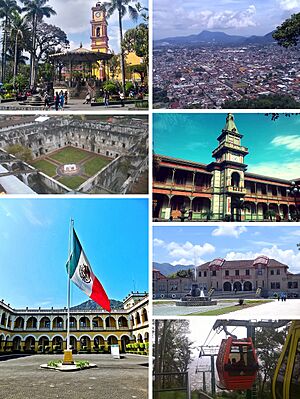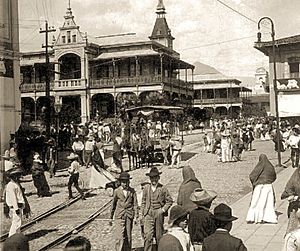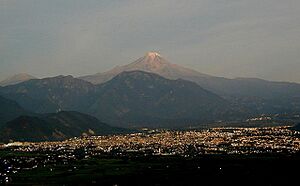Orizaba facts for kids
Quick facts for kids
Orizaba
|
||
|---|---|---|
|
Municipality and town
|
||

Clockwise, from upper left: San Miguel de Arcángel Cathedral, Panoramic of the city from El Borrego Hill, San José de Gracia Convent, Palacio de Hierro, Orizaba City Hall, Mier y Pesado Polyforum, Orizaba cableway
|
||
|
||
| Country | ||
| State | Veracruz | |
| Area | ||
| • Total | 27.9 km2 (10.8 sq mi) | |
| Elevation | 1,235 m (4,052 ft) | |
| Population
(2020)
|
||
| • Total | 123,182 | |
| • Density | 4,416.7/km2 (11,439/sq mi) | |
| • Seat | 120,500 | |
| • Metro | 462,221 | |
| Time zone | UTC−6 (Central Standard Time) | |
| • Summer (DST) | UTC−5 (Central Daylight Time) | |
Orizaba is a lively city and a municipality in the Mexican state of Veracruz. It's about 20 kilometers (12 miles) west of its sister city, Córdoba. Orizaba is also close to Río Blanco and Ixtaczoquitlán. You can find it along Federal Highways 180 and 190.
In 2020, the city of Orizaba had about 120,500 people living there. The municipality, which is a bit larger, had a population of 123,182. The whole area around Orizaba, called the metropolitan area, is home to over 462,000 people.
North of Orizaba, in a town called Ixhuatlancillo, and in the mountains to the south (the Sierra de Zongolica), many people speak a special kind of Nahuatl language. It's often called Orizaba Nahuatl.
Contents
What Does Orizaba Mean?
The name Orizaba likely comes from the Nahuatl word Āhuilizāpan. This means "place of pleasing waters." It's a beautiful way to describe the city!
Some people think the name might come from "Harish," which was the hometown of the first Spanish settlers in 1521. This word might have changed to Ariziba or Arizaba, and then to Orizaba.
Exploring Orizaba's Geography
Orizaba is located at an elevation of about 1,200 meters (4,000 feet) above sea level. It sits where the Río Blanco river meets other smaller rivers, like the Río Orizaba. This spot is at the start of a big valley that goes west into the Sierra Madre Oriental mountains.
This location has always been important. For hundreds of years, it was a key stopping point on the main trade route between Mexico City and Veracruz on the Gulf Coast. In 1938, the area around the upper Río Blanco river became the Cañón del Río Blanco National Park.
Orizaba has a pleasant climate that is often cloudy and rainy. The soil in the Orizaba valley is very fertile, meaning it's great for growing plants. Looking over the valley from the north is the Pico de Orizaba (also called Citlaltépetl). This volcano is the highest mountain in Mexico and the third highest in North America, standing at 5,636 meters (18,490 feet) tall!
| Climate data for Orizaba (1981–2000) | |||||||||||||
|---|---|---|---|---|---|---|---|---|---|---|---|---|---|
| Month | Jan | Feb | Mar | Apr | May | Jun | Jul | Aug | Sep | Oct | Nov | Dec | Year |
| Record high °C (°F) | 31.5 (88.7) |
33.2 (91.8) |
36.2 (97.2) |
37.3 (99.1) |
38.4 (101.1) |
35.2 (95.4) |
30.0 (86.0) |
29.6 (85.3) |
31.0 (87.8) |
31.0 (87.8) |
33.4 (92.1) |
30.0 (86.0) |
38.4 (101.1) |
| Mean daily maximum °C (°F) | 21.0 (69.8) |
22.2 (72.0) |
24.1 (75.4) |
26.5 (79.7) |
27.4 (81.3) |
26.4 (79.5) |
25.1 (77.2) |
25.5 (77.9) |
25.2 (77.4) |
23.6 (74.5) |
23.0 (73.4) |
21.3 (70.3) |
24.3 (75.7) |
| Daily mean °C (°F) | 14.8 (58.6) |
15.9 (60.6) |
17.4 (63.3) |
19.5 (67.1) |
20.9 (69.6) |
20.8 (69.4) |
19.6 (67.3) |
19.8 (67.6) |
20.1 (68.2) |
18.4 (65.1) |
17.1 (62.8) |
15.7 (60.3) |
18.3 (64.9) |
| Mean daily minimum °C (°F) | 8.5 (47.3) |
9.5 (49.1) |
10.7 (51.3) |
12.6 (54.7) |
14.3 (57.7) |
15.1 (59.2) |
14.2 (57.6) |
14.1 (57.4) |
15.0 (59.0) |
13.3 (55.9) |
11.3 (52.3) |
10.1 (50.2) |
12.4 (54.3) |
| Record low °C (°F) | −1.0 (30.2) |
0.5 (32.9) |
1.0 (33.8) |
3.2 (37.8) |
6.5 (43.7) |
8.8 (47.8) |
8.5 (47.3) |
6.4 (43.5) |
1.2 (34.2) |
1.3 (34.3) |
1.0 (33.8) |
0.2 (32.4) |
−1.0 (30.2) |
| Average precipitation mm (inches) | 33.1 (1.30) |
44.2 (1.74) |
36.0 (1.42) |
57.3 (2.26) |
92.8 (3.65) |
360.0 (14.17) |
422.2 (16.62) |
397.6 (15.65) |
426.9 (16.81) |
200.0 (7.87) |
69.0 (2.72) |
54.1 (2.13) |
2,193.3 (86.35) |
| Average precipitation days (≥ 0.1 mm) | 11.1 | 11.0 | 9.6 | 10.7 | 11.0 | 23.7 | 26.4 | 26.5 | 25.5 | 20.6 | 11.4 | 12.5 | 200.0 |
| Average relative humidity (%) | 79 | 76 | 73 | 72 | 74 | 78 | 81 | 80 | 82 | 82 | 80 | 81 | 78 |
| Mean monthly sunshine hours | 135 | 125 | 143 | 147 | 136 | 122 | 119 | 137 | 102 | 114 | 130 | 128 | 1,539 |
| Source: Servicio Meteorológico Nacional | |||||||||||||
A Look at Orizaba's History
Early Days and Spanish Arrival
Orizaba was an important town even before the Spanish arrived. A famous event happened here: La Malinche, who was an interpreter for Hernán Cortés, got married to a Spanish gentleman named Juan Jaramillo. You can find a plaque in Huiloapan that remembers this special day.
The Colonial Period
During the time when Spain ruled Mexico, Orizaba grew into a significant city.
- On January 27, 1774, the Spanish king Carlos III officially made Orizaba a "villa" (a town with special rights).
- Later, on November 29, 1830, Orizaba was declared a full "city."
The Fight for Independence
In October 1812, José María Morelos, a leader in the Mexican War of Independence, captured Orizaba. In 1821, at the end of the war, Agustín de Iturbide was in Orizaba before and after signing the Treaty of Córdoba in a nearby city. This treaty helped Mexico become independent.
Independent Mexico and Growth

In 1836, Lucas Alamán started the first textile factory in Orizaba, called Cocolapan. This marked the beginning of Orizaba's growth as an industrial city.
In 1839, the newspaper La Luz was created. Also, the governor of Veracruz, Francisco Hernández y Hernández, named the state Veracruz-Llave. This was to honor General Ignacio de la Llave, who was born in Orizaba.
For a short time, Orizaba was even the capital city of Veracruz! This happened on May 8, 1874, by order of Governor Apolinar Castillo. However, in 1878, the capital was moved to Xalapa.
During the time when Porfirio Díaz was president (known as the Porfiriato), Orizaba was known as the most educated city in the state.
Towards the end of Díaz's rule, there were important worker strikes. One big strike happened in Río Blanco, near Orizaba. This event was a major step leading up to the Mexican Revolution.
A US transport ship, the USS Orizaba (ID-1536), which was used in both World Wars, was named after the city.
Orizaba's Population
| Historical population | ||
|---|---|---|
| Year | Pop. | ±% |
| 1995 | 114,425 | — |
| 2000 | 118,593 | +3.6% |
| 2005 | 117,289 | −1.1% |
| 2010 | 120,995 | +3.2% |
| 2015 | 126,005 | +4.1% |
| 2020 | 123,182 | −2.2% |
In 2020, the municipality of Orizaba had 123,182 people. This makes it the seventh largest municipality in Veracruz. Most of the people (over 97%) live in Orizaba City. There are also smaller communities like Villas de la Hacienda.
About 4,452 people in Orizaba live in homes where indigenous languages are spoken. Of these, 1,883 people actually speak an indigenous language.
Orizaba is also the center of a larger metropolitan area. This area includes 11 other municipalities, such as Atzacan and Río Blanco. In 2020, this larger area had a population of 462,221 people. It is the fourth largest metropolitan area in the state.
Orizaba's Economy
The economy in the Orizaba area has grown a lot recently. This is because the area is safe, which makes it a good place for businesses to invest. There are also well-known universities nearby, like Universidad Veracruzana.
The main industries in Orizaba include:
- Breweries (making beer)
- Paper production
- Cement manufacturing
- Pharmaceuticals (medicines)
- Iron and steel
- Soft drinks and food
- Leather and shoe companies
In recent years, the shopping scene has also grown, with new malls and big stores opening.
A study in 2012 found that Orizaba is one of the most affordable cities to live and invest in Mexico. The study compared prices of 182 products and services in 42 Mexican cities. The Orizaba Valley is expected to keep growing. This is partly because it has low pollution and plenty of water.
Top Places to See in Orizaba

- The Iron Palace (El Palacio de Hierro): This amazing old city hall is in the center of Orizaba. It was designed by Gustave Eiffel, the same person who designed the Eiffel Tower! The palace was built from 1891 to 1894. It was made with 600 tons of steel, and its parts were shipped all the way from Belgium. Then, it was put together in Orizaba. It used to be the City Hall, but now it's a museum and cultural center.
- Cervecería Cuauhtémoc Moctezuma: Orizaba has an important industrial history. This brewery was started in Orizaba in 1896.
Other fun places to visit include:
- The Teleférico (Cable Car): You can ride a cable car to the top of Cerro Borrego hill. From there, you get amazing views of Pico de Orizaba. The best time to see the volcano is in the morning. You can also hike up the hill if you prefer!
- Río Orizaba and Eco Parque Río: The Río Orizaba river flows through the city. Along its banks, you'll find Eco Parque Río. This park has many wild and domesticated animals that you can see while walking along the river. There's also a nice path called the Riverwalk.
- BIORI Jardín Botánico de Orizaba: This is Orizaba's Botanical Garden. It has many different kinds of plants and outdoor art. There's even a special building just for growing beautiful orchids!
Important Buildings and Monuments
- The Iron Palace
- El Palacio Municipal (The City Hall)
- The Church of Nuestra Señora Del Carmen
- The Church of La Concordia
- State Art Museum
- Artisan market (Mercado de Artesanías)
- Mercado Cerritos and Mercado Melchor Ocampo (local markets)
- Centro Orizaba park (Parque Castillo) and its theater, which often has free plays or music at night.
- A huge rock in the Panteon (municipal cemetery).
Famous People from Orizaba
Many notable people were born or lived in Orizaba, including:
- Sara García (an actress)
- Ignacio de la Llave (a general and governor)
- Salvador Moreno Manzano (a composer, art historian, and painter)
- Saúl Sánchez (a boxer)
- Alfredo "El Viejo" Sánchez García (a footballer)
- Francisco Gabilondo Soler (a famous children's music composer)
- José Antonio Gómez Rosas
- Humberto Vélez (a voice actor)
- Evita Muñoz (an actress, also known as "Chachita")
- Ramón Arnaud
- Gilberto Loyo
- Angelica Chain (an actress)
See also
 In Spanish: Orizaba para niños
In Spanish: Orizaba para niños






